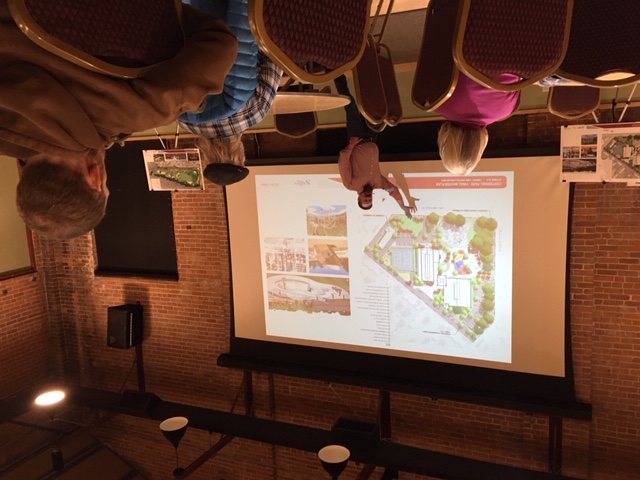Progress on the Salida Parks Recreation Open Space and Trails Master Plan (PROST) took another leap forward in the past week, with a public presentation of the plan on Jan. 20, and a work session with Salida City Council scheduled for Feb. 6. The Parks and Recreation Department is aiming for the adoption of the master plan during the Feb. 18 City Council session. Following that, the final master plan is expected to be available on the city’s website.
The PROST presentation at the SteamPlant was attended by a diverse group of nearly 50 people, who appeared eager to hear the results of the massive effort to re-imagine what the parks, trails and open space environment of Salida could become.
“This has been a huge community engagement effort,” said Parks and Recreation Director Diesel Post. “There have been four public meetings before this; some 350 participants from a population of 5,500, 12 focus groups and a community survey with more than 400 respondents. The result includes concept plans for two gateway parks – Centennial Park and Marvin Park. At 15 acres, it [Marvin] is Salida’s biggest park and has a very valuable river setting.”
Post, and acting Project Manager Jamie Sabbach (CEO of 110 www.Percent.net), walked attendees through the PROST Plan. While Marvin Park is envisioned as a passive area, with lots of green space which may function as a nature education center, Centennial Park is envisioned as an activate gathering space. Community meetings following the survey indicated that in addition to the Aquatic Center, Salida residents might be interested in a community center. There are as yet no concepts for such a center, but it could connect to the Aquatic Center with a joined entry, as well as a skate park. An aquatic amenity including soaking pools with splash pad has been discussed, estimated and re-estimated by the city of Salida for at least the past three years.
Sabbach reminded the audience that all the concepts result from extensive staff and community feedback, consulting team observations and experience. They include the six principles upon which the concepts are based, with the goal being that the process helps the department become resilient. The six pillars are:
- Organizational Resilience
- A Healthy Salida
- Quality Infrastructure
- Access & Social Equity
- Connection through Recreation
- Community Collaborations
“These plans have organizational resilience. They’re what we call ‘recession-ready,” explained Sabbach …”We want our parks and open space to have a connection through recreational access, and all of this effort on the master plan should foster community.”
The PROST effort has included extensive involvement from the City Council and the Recreation Advisory Board. Asked about funding, Post said the PROST effort could become something that could be supported by city sales tax, which includes contributions from visitors from outside Salida.
Asked about how the Vandaveer land figures into the plan, Post replied that the plan recommends that 20 to 25 acres of the parcel be devoted to parks, open space and recreational options such as multi-use ball fields. “This community is approaching 12 percent of the population at or below the poverty line, so park access is important.”
Sabbach went over PROST recommendations. “First, we’re recommending that dogs be allowed in parks on leashes. I’ve been in this field for 30 years, and I’ve never seen a city that didn’t allow dogs in parks.”
She pointed out that the plan could benefit from input from a the city’s youth, and it should be responsive to changing recreational activity trends. “Things like e-sports, gaming, cause-related events,” said Sabbach.
In keeping with the care the city council is taking during plan development, other ideas to enhance the plan include recreation opportunities for children with working parents, and perhaps even envisioning a pedestrian mall.”
Post and Sabbach reinforced the need for partnerships for the PROST plan, including not just Salida Schools, but new and existing memorandums of understanding (MOU) with other entities to enhance the plan. Currently, the city has three related MOU’s: The Salida Golf Course, Salida Parks Open Space and Trails (SPOT) and the Salida Community Center.
Among questions asked by the public, including how one would apply to be on a Salida Recreation Advisory Board (including terms of service) and what impact the various vacation rentals (VRBOs) spread across the city might have on the plan. The involvement of volunteer organizations was raised, many of which operate independently of the city, doing good work, but not always keeping the city informed.
“We need volunteer organizations [working with us], but we also need to be part of what is going on, because they are being done on city land,” said Post.
“We have a responsibility to be good stewards of the land,” said Rick Humm. “Vandaveer is an opportunity to be a better steward. I’m delighted that the concept of master planning the Vandaveer and the Little Arkansas [river] is part of this. We need to ask how we can make that as healthy a river as possible.”
The next steps in the project include an Asset Management Assessment that will be done free of charge for the city by a group called Productive Parks, out of Chicago. “They’ll map and inventory every single asset in the community, including the sub amenities,” said Post. “They’ll assign their value, the funds needed to maintain, and/or replace the amenity at the end of their useful life. People need to understand that with parks and recreation assets, there is the original construction cost, and then there is the lifetime maintenance.”








Recent Comments